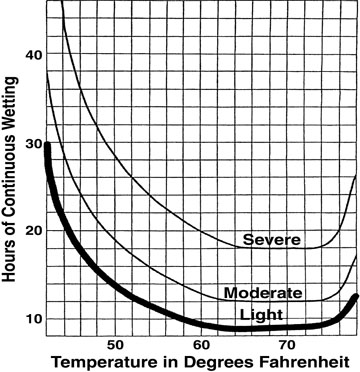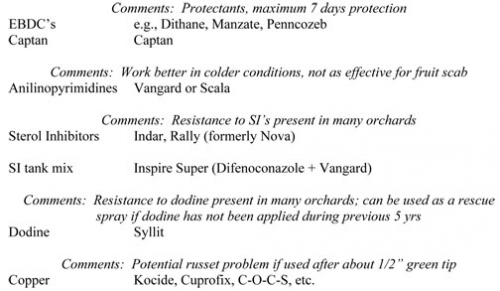The 2009 season tree fruit diseases
Editor’s note: This article is from the archives of the MSU Crop Advisory Team Alerts. Check the label of any pesticide referenced to ensure your use is included.
In this article, I will review what we’ve observed and learned in 2009 and try to explain mechanistically the cause of disease issues we’ve faced this year. Before that, I want to acknowledge the excellent MSU Extension folks in the state (Mira Danilovic, Amy Irish-Brown, Erin Lizotte, Mark Longstroth, Nikki Rothwell, Phil Schwallier, Bill Shane, and Bob Tritten) that work long and hard to stay on top of things in the tree fruit world. I am indebted to these dedicated professionals, rely on them for information, and enjoy the many “fruitful” discussions we have.
Apple scab
2009 was a difficult year for managing apple scab and the next few years will likely be just as difficult. First, we faced the difficulty of losing the strobilurin fungicides on the Ridge, as we recovered significant levels of strobilurin-resistant apple scab fungal isolates in 2008. Combining this loss of an important fungicide with a significant apple scab infection period in late April led to scab symptoms showing up and causing problems throughout the season. One note on the strobilurin resistance testing that is ongoing in my laboratory. We have sampled approximately 70 orchards throughout the state and a few more in Wisconsin and Ontario. Currently, we have approximately 2,000 isolates of the apple scab fungus ready for testing. These isolates all have to be propagated and replicates put into long-term storage prior to testing. We have just initiated the testing of the first isolates for strobilurin resistance. We are also testing each isolate for resistance to sterol-inhibitor (SI) fungicides. We hope to complete the testing and have all results by the Great Lakes Fruit and Vegetable Expo in December. All growers with orchards that we’ve tested will be informed individually concerning the results. I will also be communicating results on a regional basis throughout the winter so everyone is up to date about the resistance status of the apple scab fungus in their regions.
Weather conditions provide the most difficulty when assessing the prospects for disease occurrence in any season. Conducive weather is always difficult because even the best managed programs can still be defeated by rapidly growing pathogens. The situation with apple scab in Michigan illustrates this concept. In late April, extended periods of wet weather combined with average temperatures in the high 40’s to low 50’s were enough to constitute severe infection events for scab in most apple-growing regions of Michigan (Table 1). The wetting hours were typically far above the necessary timing for scab infection according to the Mills model modified by Jones (Fig. 1). The Mills model, with wetness durations modified by Jones, is published in tabular format in the Michigan Fruit Management Guide (pg. 59 in the 2009 edition). For example, at an average temperature of 53°F, 25 hrs of continuous wetting are required for a severe infection event, while 36 hr were observed in Sparta between 25-27 April. Heavy rainfall compounded the situation, leaving newly-developing foliage unprotected during several hours of infection.
The multiple, closely-occurring wetting events in Michigan this year interfered with fungicide applications resulting in orchard blocks that were unprotected. These blocks were subsequently infected by the scab fungus. Once scab infection occurs during primary scab season, growers must actively manage scab throughout the rest of the season as these primary lesions produce conidia (asexual spores). These conidia greatly increase the amount of scab inoculum in the orchard, meaning there is much more to control, and for a longer period of time.
Table 1. Heavy (severe) infection periods for apple scab infection in various locations in Michigan in 2009.
| Location | Date(s) | Wetting period | Average temperature | Rainfall |
| Bainbridge | 19-22 April | 59 hr | 41.0 | 1.04” |
| Bainbridge | 27-29 April | 29 hr | 54.2 | 1.25” |
| Bainbridge | 30 Apr – 2 May | 38 hr | 52.0 | 0.37” |
| Sparta | 25-27 April | 36 hr | 53.6 F | 3.57” |
| Sparta | 30 Apr – 1 May | 20 hr | 55.4 | 1.33” |
| Hart | 19-22 Apr | 68 hr | 38.0 | 1.07” |
| Hart | 25-27 Apr | 41 hr | 48.5 | 1.58” |
| Traverse City | 25-27 Apr | 52 hr | 44.5 | 0.97 |
Figure 1. Mills table showing the relationship between wetness duration, temperature, and degree of apple scab infection. Originally published in Mills (1944) Cornell University Extension Bulletin 630:1-4.

Fungicides available for apple scab management
With the probable loss of strobilurins in all apple-growing areas of Michigan, the available alternatives are dwindling and include: EBDC’s, Captan, Anilinopyrimidines (AP’s), Syllit (dodine), sterol inhibitors (SI’s), and copper (Table 2).
Table 2. Available fungicides for apple scab control in Michigan for 2010.

We will revisit the issues with fungicide resistance, and available fungicides during the winter and prior to the 2010 season when we have all of the results from the fungicide resistance testing. Also, see the accompanying article on strategies for reducing overwintering inoculum of the scab fungus on leaves on the orchard floor.
Fire blight
Fire blight seemed to mostly be a problem on older Jonathan trees that did not receive a complete management program. Jonathan is one of the most, if not the most, susceptible variety to fire blight grown in Michigan. We also faced issues with an extended bloom period and infection that occurred on late bloom. When this occurs on Jonathan, even a relatively small amount of blossom infection can lead to significant shoot blight later. We observed trees on the Ridge and in southwest Michigan harboring a tremendous number of shoot blight infections. Shoot blight can be effectively kept in check with Apogee; Apogee treatments sharply reduce apple shoot growth and thicken cell walls inside the shoot making it difficult and in most cases impossible for the fire blight pathogen to infect the shoot. Older trees are typically able to recover from extensive fire blight infection in the following season if an effective disease-control program is utilized.
Streptomycin resistance continues to be a major problem for fire blight control. In areas with resistance, alternatives for blossom blight control include the alternate antibiotic Kasumin. A Section 18 specific exemption for the use of Kasumin in 2009 was granted late by the EPA resulting in delayed availability of Kasumin to growers this year. We are anticipating that Kasumin will be available earlier in 2010. Other streptomycin alternatives include oxytetracycline (Mycoshield or the generic compound FlameOut) and the biological controls Serenade MAX, and bacterial antagonists BlightBan and Bloomtime. However, only Kasumin is as effective as streptomycin; while the other materials may control blossom blight, they do not kill the pathogen like streptomycin does. Thus, inoculum remains in the tree, which can lead to shoot blight infections.
In orchards with existing streptomycin resistance problems, the use of Apogee is critical. Apogee is a growth inhibitor that reduces shoot growth. This reduced growth is accompanied by increased shoot blight control as the fire blight pathogen tends to infect only actively-growing shoots. Apogee use is critical because this shoot blight control is effective against both streptomycin-susceptible and streptomycin-resistant strains of the fire blight pathogen. Do not use Apogee on ‘Empire’ and ‘Winesap’ as fruit cracking may occur. While the Apogee effect on Jonathan trees is reduced compared to other varieties, it can still help control shoot blight under high pressure situations like those experienced in 2009.
Summary
When environmental conditions favor disease, disease will occur. Even when conditions are unfavorable, we must remember that inoculum may still be around. For example, in years with cold temperatures during apple bloom where we might escape blossom blight infection, the fire blight pathogen will eventually ooze out of cankers providing inoculum for subsequent shoot blight. Each infection event enables the pathogen to increase population size meaning that further control attempts must then deal with increased inoculum. Proper protection of susceptible tissue is the key.
The last thing to remember is we grow many acres of highly disease-susceptible varieties in Michigan. For example, Jonathan and Gala for fire blight and McIntosh for apple scab. When disease susceptibility is high, the pathogen is heavily favored. For example, if a much smaller population size is required to cause blight on a highly-susceptible variety, it makes it much more difficult if not impossible to adequately control. This also reinforces the need for active and efficient disease management and resistance management of existing bactericides and fungicides for long-term protection.



 Print
Print Email
Email


